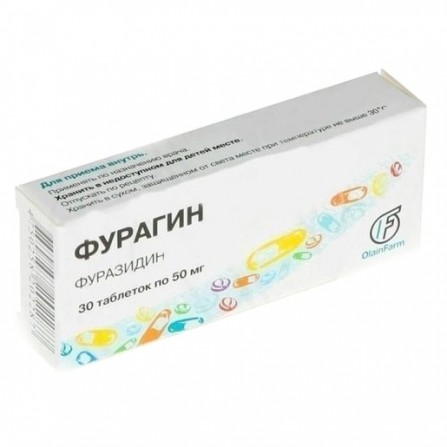Furagin-actifur capsules 50mg N30
Condition: New product
1000 Items
Rating:
Be the first to write a review!

More info
Active ingredients
Furazidin
Composition
1 caps Furazidin sodium 62.5 mg, which corresponds to the content of 50 mg furazidina. Excipients: magnesium carbonate basic aqueous 72 mg, starch, pregelatinized corn starch 45.
Pharmacological effect
Antimicrobial agent of broad-spectrum, belongs to the group of nitrofurans. Under the influence of nitrofurans, the respiratory chain and the tricarboxylic acid cycle (Krebs cycle) are suppressed, as well as the suppression of other biochemical processes of microorganisms, as a result of which their membrane or cytoplasmic membrane is destroyed. Active against gram-positive cocci: Streptococcus spp., Staphylococcus spp .; Gram-negative bacilli: Escherichia coli, Salmonella spp., Shigella spp., Proteus spp., Klebsiella spp., Enterobacter spp .; protozoa: Lamblia intestinalis and other microorganisms resistant to antibiotics. With respect to Staphylococcus spp., Escherichia coli, Aerobacter aerogenes, Bacterium citrovorum, Proteus mirabilis, Proteus morganii, furazidin is more active than other nitrofurans. For most of the bacteria, the bacteriostatic concentration ranges from 1: 100,000 to 1: 200,000. The bactericidal concentration is about 2 times greater. As a result of the action of nitrofurans, microorganisms secrete less toxins; therefore, an improvement in the general condition of the patient is possible even before the marked suppression of the growth of microflora. Nitrofurans activate the body's immune system: they increase the titer of complement and the ability of leukocytes to phagocytose microorganisms. In therapeutic doses, furazidine stimulates leukopoiesis. Furazidine resistance develops slowly and does not reach a high degree.
Pharmacokinetics
After oral administration, furazidin is absorbed from the small intestine by passive diffusion. The absorption of nitrofurans from the distal segment of the small intestine exceeds the absorption from the proximal and medial segments by 2 and 4 times, respectively (should be considered when simultaneously treating urogenital infections and diseases of the gastrointestinal tract, in particular chronic enteritis). Nitrofurans are poorly absorbed from the colon. Cmax in the blood plasma lasts from 3 to 7 or 8 hours, in the urine furazidin is detected after 3-4 hours. In the body, furazidin is distributed evenly. Clinically important is the high content of the drug in the lymph (delaying the spread of infection through the lymphatic ducts). In bile, its concentration is several times higher than in serum, and in the cerebrospinal fluid - several times lower than in serum.In saliva, the content of furazidine is 30% of its concentration in serum. The concentration of furazidine in the blood and tissues is relatively small, which is associated with its rapid release, while the concentration in the urine is much higher than in the blood. Metabolized to an insignificant degree (less than 10%). Excreted by the kidneys by glomerular filtration and tubular secretion (85%), partially undergoes reverse reabsorption in the tubules. At low concentrations of furazidine in the urine, filtration and secretion predominate, at high concentrations, secretion decreases and reabsorption increases. Furazidin, being a weak acid in acid urine does not dissociate, is subjected to intensive reabsorption, which can enhance the development of systemic side effects. When alkaline urine excretion of furazidina increases. With a decrease in renal excretory function, the metabolic rate increases.
Indications
For oral administration: urogenital infections (acute cystitis, urethritis, pyelonephritis) gynecological infections of the skin and soft tissue infections, severe infected burns with prophylactic purposes during urological operations (including cystoscopy, catheterization). For external and local use: infectious and inflammatory diseases of the oral cavity and pharynx, infected wounds.
Contraindications
Chronic renal failure, severe pregnancy, lactation period (breastfeeding) children up to 4 years of age are more sensitive to furazidine and other nitrofurans.
Use during pregnancy and lactation
The drug is contraindicated during pregnancy and lactation (breastfeeding).
Dosage and administration
Is ingested after a meal. Adults - 50-100 mg 3 times / day, children over 3 years old - 25-50 mg (no more than 5 mg / kg body weight) 3 times / day. The course of treatment is 7-10 days. If necessary, repeat the course of treatment should be a break for 10-15 days. For the prevention of infection (including during urological operations, cystoscopy, catheterization) - 50 mg once 30 minutes before the procedure. Apply externally 2-3 times / day for washing wounds or wetting a dressing material. Apply topically 2-3 times / day in the form of mouthwash and throats.
Side effects
On the part of the digestive system: rarely - nausea, vomiting, loss of appetite, abnormal liver function. From the side of the central nervous system and peripheral nervous system: rarely - headache, dizziness, polyneuritis. Allergic reactions: rarely - skin rash (including papular rash).
Interaction with other drugs
When combining furazidina with ristomycin, chloramphenicol, sulfonamides increases the risk of hematopoietic depression (should not be used simultaneously). It is not recommended to use drugs capable of acidifying urine (including ascorbic acid, calcium chloride) simultaneously with nitrofurans.
special instructions
To reduce the likelihood of side effects, furazidine is washed down with plenty of liquid. With the appearance of side effects, use should be discontinued (toxic effects are more common in patients with reduced renal excretory function). During the period of treatment, the patient is advised to abstain from alcohol because of possible side effects. Do not take double the dose to compensate for the missed dose. Use with caution when glucose-6-phosphate dehydrogenase deficiency.





